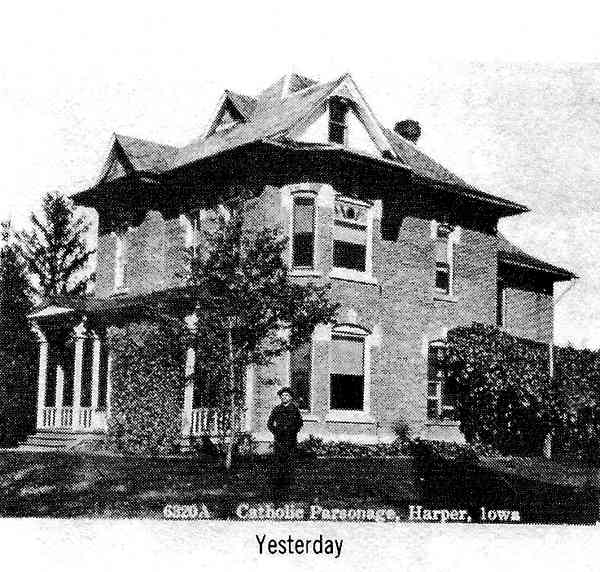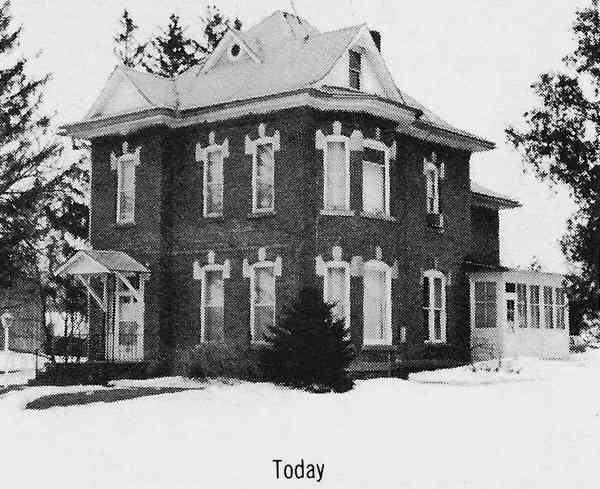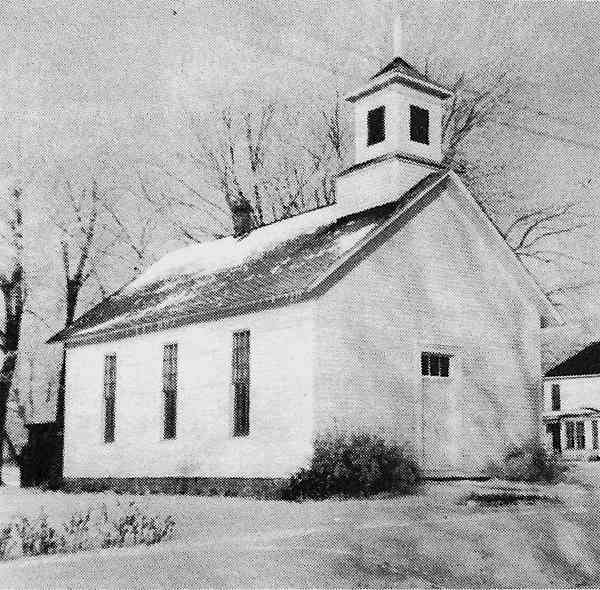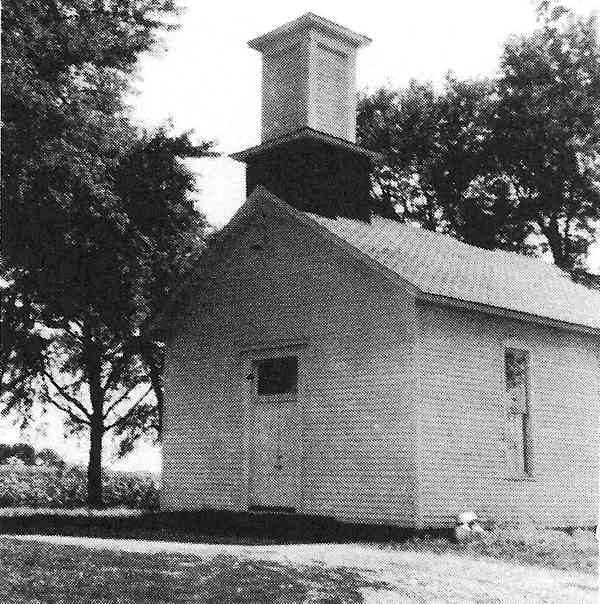What's New | Bios | Birth/Marr/Death | Cemeteries | Census | Courts | Directories/Lists | History | Land & Property | Military | Photos & Postcards | Resources | Schools
ST. ELIZABETH'S CHURCH & PARISH
| The organization of St. Elizabeth's Parish may be traced back as far as the original settlers of Baden. In the early times of this settlement, the spiritual wants of these pioneers were attended to by missionaries who happened to pass, or some priests from Iowa City or Dubuque. These priests celebrated Mass and administered the sacraments in the homes of the various settlers. The first Mass for the settlers was celebrated by Fr. Michel in Nick Berg's log cabin since the house was quite centrally located. In 1856, thirty-three Catholic citizens petitioned Bishop Loras of Dubuque to send them a priest, and the same year Rev. John Krekel came from Ottumwa to organize a parish under the patronage of St. Elizabeth of Hungary. Twenty acres of land were donated; Sebastian Striegel, Jr., 5 acres; John N. Herman, 5 acres; Andreas Bleyle, 5 acres; John Klapping, 2 1/2 acres; and Joseph Heringer, 2 1/2 acres. The site chosen was on the outskirts of town, near the cemetery. The first church, a frame structure, 20' x 30' built of hard wood sawed in the timbers nearby, had a gable roof, faced west and was built in 1857 from a collection taken on 11-20-1856 in the amount of $404.50. In 1862 the parish bought a bell which weighed 700 lbs. and bore the date and a cross. The Rev. John B. Temmons was appointed first resident pastor of Baden. He lived in a one room structure he built himself until a four room parsonage was erected. Fr. Temmons served two years and a young priest, Rev. Gerhard Luersman was his successor in 1870. He moved the church from the cemetery lot into town directly across from the parsonage and opened the first Catholic school in Keokuk County. The school was located west of the church. He was succeeded by an aged priest, Rev. Frauenhofer, followed by Fr. Peter Kern in 1876. At this time the church was becoming too small to house the growing congregation and since Harper was becoming the dominant community center, it was deemed advisable to transfer the new church there. As a result, the present church still in use today, was started in 1883 and finished early enough to use during the Christmas season of 1884. |
| Mr. J. H. B. Striegel donated the land for the building. It is a brick structure, the main part 66' x 37 feet and the sanctuary 24' x 37', making a complete length of 100 feet and a height of about 30 feet. A large gallery spreads over the entire west end of the church. On the north of the sanctuary is a sacristy 14' x 14' and 10' high. The tower of the church is 10' square and rises from the ground to the tip of the cross, which tops the steeple. The tower is 150 feet high and is surmounted by the steeple, 12 feet x 8 feet, Today thus making a total of 162 feet. It can be sighted in any direction five miles from town. The twelve full-length windows are stained glass with square shaped panes carrying simple designs in variegated colors and bordered in floral or cheat and grape design. Near the top of the window, religious symbols stand in bright colors and near the bottom, information as to the donor. The first lighting was acetylene produced by water dropping on calcium carbide. |
| The first heat was supplied by two large stoves on the north and south sides. The large cross, 10'8" with a cross beam of 5'4" from the eight mission of 1862 at Baden was transferred to the new church and still can be seen in the vestibule. |

| In 1887, Fr. Kern was transferred and was succeeded by Fr. John Fedler, who in 1888 erected the present parsonage. |


| After eight years of labor, he was succeeded by Rev. H. Grothe, who took a great interest in the school and in 1900 erected a two story brick building with four classrooms. He also transferred the cemetery to the present location. Land was secured from Mr. Striegel and Mr. Boss and it was located directly across from the church property. Mrs. Striegel was the first parishioner to be buried on the newly planted "God's Acre". On June 16, 1901, Rev. John Adam, born in 1972 at Baden. Germany, was ordained and read his First Mass on June 19. In 1904, two large bells were purchased, the larger one, christened St. Elizabeth, cost $350 and weighed 2000 lbs. The second, a somewhat smaller bell, was christened St. Joseph and St. John. It cost $175 and weighed 1100 lbs. These bells, together with the 1862 bell transferred from Baden were tuned to E, G, and B flat and when rung together, give a most pleasing sound. In 1915, after 19 years as pastor of the parish, Fr. Grothe was removed to West Point where he died in 1933. Rev. Bernard Luedtke followed. His first transaction was the erection of the rotunda in the cemetery and placed therein the Crucifixion group. Also realizing the needs of higher education, he built a fine brick addition to the school in 1917 which serves as the Sister's apartments. The vacated rooms were utilized as classrooms for the High School department. In 1923, upon the request of Fr. Henry Sendbuehlar, the school was fully accredited. Rev. Francis Schaeffer took charge of the building of Marquette Hall in 1927. It was never completed according to plans, mainly due to the depression of the years. In 1933, the Golden Anniversary of St. Elizabeth's Parish was celebrated. A 1936 fire severly damaged the church and services were held in Marquette Hall. At this time the church was given its first coat of paint. Rev. J. J. Schoenfelder started his pastorate in 1937. He secured new fire-fighting equipment in 1941 and arranged with Natural Gas Pipeline Co. of America for a sufficient water supply. The original pipe organ, a Wicks "T" with 4, 785 pipes, purchased in 1915, was electrified in 1940 at a cost of $1875. Previously it was operated by means of bellows which had to be hand-pumped. |

| Rev. Wilbur Sondag, son of Mr. & Mrs. John Sondag and a graduate of St. Elizabeth's Class of 1934, was ordained a priest in 1942, the first of St. Elizabeth's sons to answer the call to the pastorate. World War II was declared and a good number of young men from the parish entered the service. Fr. Schoenfelder was County Chairman for War Bond Sales, Red Cross war drive and U. S. O. Fund. Keokuk County was the first to "go over the top" in 1945. The goal was $13, 901 but the drive netted 12,440. The additional funds were used to send a package to every boy and girl in the service from the County at Christmas, 1800 one year, 1900 the next. Fr. Schoenfelder graciously opened the rectory as a meeting place where bandages were folded for the Red Cross. The State Officials paid high tribute to the people of the County and especially to Fr. Schoenfelder for being chairman of all these drives. He was transferred to Muscatine and in 1949 was replaced by Rev. M. J. Diamond. One of his first acts was to redecorate the church at a cost of more than $5,000. Improvements in the school was one of his ambitions. Noted improvements were flourescent lighting, in-door lavoratories, a well to furnish sufficient water and tiled floors. A two acre plot of ground was purchased from Mr. Raymond Striegel and turned into a playground and ball field. The grounds were lighted electrically at a great cost to Fr. Diamond. Plans were again fostered in 1955 for an addition to the school and in 1957 a new structure was added. By 1961 all parish buildings were remodeled for the use of gas in place of coal for heating. 1963 saw the transfer of priests again, this time to Rev. Edward Collins and once again in 1966 when Rev. John W. Schmitz was assigned to St. Elizabeth's. The church was freshly painted and repaired and carpet was installed in the area of the sanctuary. New altars were added at this time also. |
| Each pastor took a great interest in the church, school, cemetery and grounds. In the fall of 1977, the present pastor, Rev. Robert McAleer was assigned to the parish. His youthful vigor will be a great asset to St. Elizabeth's. Thus it is that the little settlement made at Baden has continued to flourish to the present day. The cemetery, a "beauty spot" just across the way from the church speaks in silent eloquence and esteem in memory of the many noble souls who first plodded the way and is held today by their posterity. |

HARPER METHODIST CHURCH
| July 26, 1873, J.
P. Yerger and his wife, sold lot 1
and 2 of
block 7 to the trustees of the Methodist Church. The trustees were L.
S. Gilbert, James McJunken, M. B. Walsh, and W. A. Hetz. The
organization was already formed and the one room church was built the
same year. In the early years of Harper, the Methodist had a very
active church. Following is a description of the church written by Amelia Bower. "The church was built by two resident carpenters, Whistler and Farley. In the old days, everybody you might say, turned out to help build the church, for those days a church was as essential to our well-being as the air we breathe‚€”were it so now. The men took their log wagons, their horses and ox teams out to the woods and hewed out the timbers, then hauled them to the two lots in the outskirts of the town, which I believe were donated by John Holzworth, for the site of the new church. A board fence was built around the church and hitching racks on the north and east sides and a "stile" in front with the steps on each side for convenience of those who rode or drove, for these were the days of horse back riding and of buggies, spring wagons and, yes, even of farm wagons. The fence, hitching racks and stile have long since disappeared, but the old church, despite its many ups and downs, is standing staunch and true as ever, thank God. But sad to say, the number of members has dwindled to almost nothing, since the old congregation has passed on, but the few who are left are still pressing on to the goal. One man told me to be sure to write that Mrs. Salisbury was the "backbone" of the church. Then I think back to those days, when there were many "backbones" in our little church, all those dear old sisters and brothers of the Lord. I hope soon to meet in an unknown "circle in the sky, " the Richardsons, the Ren- frews, the Salisburys, the Rosencrans, the Whistlers, the Wingets, the Keeleys, the Fishers, etc., etc.
Our furniture dealer, John Ludwig, an old Catholic gentleman, donated a table which is a curio now with its movable top and receptacle beneath. In these late years Rev. Banghart donated a picture of the "Lord's Supper" which we prize very highly, and also a reading stand from the Rev. Pike. "We have been most fortunate in having ministers from the Bethel Church during the last 13 years who have done much work for the Lord, instead of for money, and in that we have such true Christian neighbors, as our Catholic friends have been to us. For were it not for that, we would have had to close the doors long ago. But the Lord will provide as long as we put our trust in Him and we hope to carry on until He calls, and may we heed that call. We need not go to war or fight and shed blood to be obedient to that call, but live like Jesus did when He was here on earth." Signed‚€”Amelia Bower 1939 Through the years the church had a very active Sunday School. In 1932 Rev. Paul Hamilton was minister, Amelia Bower was superintendent of the Sunday School and Clara Crooks was her assistant. The teachers were Rev. Paul Hamilton, Amelia Bower, Edna Wilson, Mrs. Stapleton, Mrs. Ed- mondson, Clara Crooks, and Mrs. Yoder. Mary Simmons was secretary, with Virginia Clarahan as her assistant. Organist was Grace Clarahan. Mary Morrison was appointed to take charge of a Junior Choir. In April of 1934 the church sold the south lot to Jess Gable. The trustees at that time were Mrs. W. H. Crooks, Mrs. Fred Wilson, and Mrs. H. P. Clarahan. The church joined the Southeast Iowa Methodist Conference in 1939. The Harper church was to be a mission church with the minister from the Keota Methodist church preaching the Sunday Service. The following year the church was redecorated. The steeple was rebuilt, the outside painted, the interior was painted and electric lights installed. All of the labor and most of the material were donated. Some of the last ministers to serve the church were Rev. Paul Hamilton, Rev. Barnhart, Rev. Colman, Rev. Prichard, Rev. Betz, Rev. Greer, and Rev. William Smith. Over the years the parish attendance had dropped and by 1957 the conference had warned the church if attendance didn't pick up they would close the church in six weeks. The attendance didn't pick up and in six weeks the church was closed and put up for sale. Henry and Marilyn Williams bought the church and land. In 1958 they tore the church down and built a home on the lot. The pews, pulpit, and piano went to the Methodist Church in Keota for their use. |

SCOTLAND
PRESBYTERIAN
CHURCH
|
The northern part of Lafayette Township was settled largely by people of Scottish origin whose families had first settled in Tazewell, Illinois, then in 1854 came on to Iowa. Very soon, they began to investigate the possibility of establishing a Presbyterian Chruch in the community. Citizens in and about Sigourney met together at a Session meeting at South English on September 23, 1855, under the direction of officials of the Des Moines Presbytery, and the Church was fully organized. The following year a small frame building was erected in Sigourney with Rev. S. C. Kerr as the first pastor. He also conducted services in the homes at South English and Webster and often in the Wilson Schoolhouse that was also known as the Scotland School. In October of 1859, the members in the eastern part of the area petitioned the Presbytery of Des Moines to organize themselves into a separate church. This petition was denied, and it was not until January 29, 1860, that the Church of Lafayette was officially reported as having been organized. Rev. D. V. Smock was instrumental in getting the members organized into a separate church and served as its pastor for seventeen years. In 1869, the frame church was built and dedicated to Rev. Smock. In 1922, the Church was closed and the membership was transferred to the Keota Presbyterian Church. This did not prove satisfactory, and on June 1937, the Lafayette Presbyterian Church was organized. Though the Church was closed from 1922 to 1937, the Sunday School, which had been started in January 1885, reorganized in 1931, six years before the Church was reorganized. Ministers from the Keota Presbyterian Church, and later, the Federated Church, served the Scotland congregation for many years. This Church was located in Section 8 of Layfayette Township, just east of the Loren Turnipseed home. In late years, the congregation voted to disband and the building was eventually sold in 1962 to Hal Huber who moved it to his farm. At a later date the building was again sold to Mr. Humphrey; a church converted into a farm building. A ladies association, known as the Scotland Kensington was organized with the aim to promote the best interests of the community. While not a church organization, it had a close association with the Church. CEMETERIES SERVING THE HARPER COMMUNITY History records that along with the anticipation of establishing new homes, our pioneers were faced with the trauma of illness, and often death, in their families and realized the necessity of providing a place for the burial of their deceased. Before cemeteries were established, burials were made in an appropriate spot in a farm field, or even in the yard of a home. The first Catholic Cemetery to serve the new community of Baden was laid out on the Berg farm. Later most of the bodies were moved to Baden and Clear Creek Cemeteries when those cemeteries were established. However, the location of a few of them was lost, and they are still buried there. The present owner of this farm is Michael Berg, a great-great-grandson of the original owner, Michael Berg, who bought the land from the government in 1849. The first death in Lafayette Township, then a part of a larger area called Clear Creek Precinct, was that of Peter Besser in October, 1844. Mr. Besser and his family had come from Germany to make a new home in Iowa, and had been in the township only about two weeks when he became ill with malarial fever which took his life. An article in the June 20, 1946 edition of the Keokuk County News states that Peter Besser's burial on October 11, 1844, was the first in- terment in the Shockley, sometimes called the Hornish, graveyard which is located southwest of Talleyrand, and is one of the oldest cemeteries in the county. Peter Besser was the father of Nicholas Besser, and a great-grandfather of William and Francis Besser of the Harper community. Baden Cemetery A few years after the town of Baden was platted and settled, and a Catholic Parish organized with the building of its first Church, the pioneers, to make their community complete, realized the need to have a parish cemetery established there. In July 1863, Ana K. Herman gave seven and a half acres of her farm, which was across the road east of the town, for the cemetery. This farm still carries the Herman name, being owned by Howard and Myron Herman, her great-grandsons. From the information available, the burial of Julie Michel, the two and a half year old daughter of Phillip and Eva Michel, who died September 28, 1863, can be considered one of the earliest burials, if not the first. With the founding of the town of Harper, St. Elizabeth Parish moved the Church to the new location. However, Baden Cemetery continued to have burials there until the early 1900's. As years passed by the cemetery fell into a period of neglect. Many of the headstones had fallen and some were broken. Those headstones not repaired and reset by families of the deceased were buried in the cemetery a little to the southeast of the gate. With the absence of many headstones, and there being no known plat of the cemetery, an accurate record of the burials is unavailable. In 1970, the cemetery became the property of Lafayette Township under the supervision of its Board of Trustees. Consequently, it is now receiving township maintenance funds, is fenced, has an entrance gate, and is being well cared for. St. Elizabeth Catholic Cemetery In 1902, during the pastorate of Rev. H.
Grothe, St.
Elizabeth's Parish secured 1.79 acres of land from Mr. V. N. Striegel
and 1.28 acres from Mr. Peter Boss, directly across the road from the
Church for the Parish Cemetery. An interesting feature of the original
layout of the cemetery is that the wide walkways were designed in the
form of the Cross, and the burial plots filling in the remaining area. |

| Soon after Rev.
Bernard
Luedtke became pastor of St. Elizabeth Church
in late 1915, he had erected at the intersection of the vertical and
horizontal lines of the cross, a beautiful
Rotunda having
the
Crucifixion Group placed therein. He also established the traditional
procession from the Church to the Cemetery each Memorial Day regardless
of the weather. These processions have since been discontinued. St. Elizabeth Cemetery lies on level ground, is fenced on all sides; the fence facing the highway being a wrought iron fence, having a very attractive gateway at the center. There is a drive along the north, west, and south sides of the present burial space, with open gateways on the east. In the early 1930's, two additional acres along the south side of the cemetery were made available by the Natural Gas Pipeline Company of America for a legal fee of 75 cents. A row of evergreen trees set by the Pipeline Company separates the respective properties. This cemetery is very well cared for and the Church's Administration Board has a plat, which is kept up-to-date and lot assignments are recorded. The first parishioner to be buried in the St. Elizabeth Catholic Cemetery was Mrs. Michael Striegel. Lafayette Cemetery Lafayette Cemetery was established presumably to fill a community need, as there was no other cemetery within a considerable distance. It is located two miles east and one-half mile north of Harper. The cemetery contains approximately five acres, divided into two equal sections, north and south. The south part is fenced and currently rented to an adjoining landowner, but remains available for burial purposes any time it may be needed. The north part is fenced, with plots and roadways mapped. Lafayette is a very beautiful cemetery, lying near the top of a small rise in the landscape, and is well cared for. Years ago evergreen trees were planted in groups of four at regular intervals over the ground. Most of these have survived to this day. Two long benches toward the east end of the cemetery were once used at the time of Memorial Day Services, a tradition which, in recent years, has been discontinued. A deed of record, dated March 20, 1871, indicates that the transfer of this land was made by the president and secretary of the School Board (Lafayette Center) to the Lafayette Cemetery Association. Originally, this Association was responsible for the maintenance of the cemetery. However, with township funds now available, this responsibility is in the hands of the Township Board of Trustees. The first burial in Lafayette Cemetery was Winthrop McLoud, the 16-year-old son of Mr. and Mrs. William McLoud. While the family was living on a farm one-half mile east of Harper, the son became ill and passed away. He was buried in the yard at the home. Later his body was moved to Lafayette Cemetery when it was opened for burials. Burials of Deceased War Veterans The tragedies of war did not by-pass families of the Harper community. We do not have a complete record of all the young men who lost their lives during a war, but we do list here all veterans who are buried in St. Elizabeth Catholic Cemetery and in Lafayette Cemetery. St. Elizabeth Catholic Cemetery: Frank Conkity, WWI, who was a member of St. Elizabeth Church at the time of his death, is buried in the Keota Cemetery. Lafayette Cemetery: |
previous page index page next page